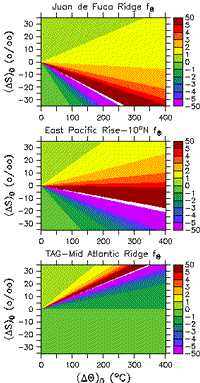| |
Hydrographic-Tracer
Relationships:
On
the Calculation of Total Heat, Salt and Tracer Fluxes from Ocean Hydrothermal
Events (Abstract)
Problem
Description:
Estimates
of heat released during event plume formation usually are based on volume
integrals of the resulting temperature anomalies measured in the water
column. Anomaly distributions, however, depend on anomaly definition.
The most commonly used definition of anomaly, defined as the difference
between plume and ambient values for points of equal density, leads to
volume integrals that do not represent the actual total heat flux released
during an event. Why is that and what must be done with that estimate
to get the correct value? This study establishes a factor, f_theta shown
here, for rescaling apparent heat flux to actual heat flux. The analysis
also leads to a relationship between the ratio of tracer to heat anomalies
measured anywhere in an event plume to a similar ratio at the event source.
 |
The
variable f_theta rescales the total apparent heat, based on the
volume integral of density-density temperature anomalies, to the
total actual heat discharged during a megaplume event. Site differences
in hydrography:
a)
Juan de Fuca Ridge
b) East Pacific Rise
c) Mid-Atlantic Ridge
The
magnitude of f_theta depends on event plume source temperature and
salinity.
click
for larger view
|
|
|

